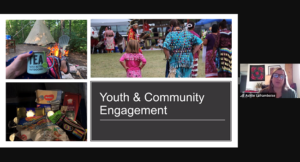NOSM and Science North engage Indigenous youth

By Rick Garrick
THUNDER BAY — The Northern Ontario School of Medicine (NOSM) and Science North recently highlighted some of their initiatives to encourage Indigenous youth across northern Ontario to pursue postsecondary education pathways in health sciences.
“I hope that with this new program partnering [with] Science North and with the wonderful support of RBC Future Launch and the Aubrey and Marla Dan Foundation, NOSM becomes more relevant for young people to pursue a career in science,” says Dr. Sarita Verma, dean, president and CEO at NOSM. “I didn’t start in science, I started as a lawyer. Actually, I started [with] acting in drama and then I became a lawyer. I was inspired to go to medicine, and you can come into health or into science later but if you’re inspired early this is important.”
NOSM and Science North signed a collaboration agreement on Apr. 20 to partner on the delivery of health, life and human sciences-related programming to Indigenous youth across northern Ontario, and received a funding commitment of $195,000 through RBC Future Launch and a $20,000 donation from the Aubrey and Marla Dan Foundation.
“With communities spread apart across an expanse of over 800,000 square kilometres, and many of them lacking consistent access to essential services, Indigenous youth in northern Ontario often find themselves isolated and disproportionately affected by the social determinants of health,” says Yolanda Wanakamik, director of Indigenous Affairs at NOSM. “By combining human resources, existing relationships with communities and schools, we can and will make an impact.”
Ashlie Laframboise, learner recruitment and support coordinator at NOSM and Red Rock Indian Band citizen, says Indigenous medical students make up about 17 per cent of this year’s incoming class at NOSM, the highest percentage of Indigenous medical students at medical schools across Canada, and have made up about eight per cent of the incoming classes since 2005.
“Along with other NOSM recruitment initiatives, we’ve been working to increase our Indigenous applications,” Laframboise says. “One of our main goals is engaging youth at a younger age to engage our community partners, organizations and groups who support youth to get them involved in the health sciences and talking to them about pathways to medical school.”
Laframboise says NOSM’s partnership with Science North has resulted in more than 1,500 youth from across northwestern Ontario being provided with access to educational programming focused on health, human sciences, balance and well-being.
“Last year we were able to host over 15 virtual high school visits and provide STEM (Science, Technology, Engineering and Mathematics) kits to over 20 communities across northwestern Ontario,” Laframboise says. “We are planning to visit another 15 high schools for virtual sessions in 2021-2022. Our STEM kits are going to be refreshed and re-envisioned for summer 2022 to send out to another 20 communities.”
Emily Kerton, outgoing senior scientist, Outreach and Indigenous Initiatives at Science North, says it has been “wonderful” to partner with NOSM to provide health sciences-related programming to First Nations youth across the region.
“Over the past 10 years, Science North has been working really hard to deepen our engagement with First Nation communities and really ensure equitable access to our unique brand of hands-on experiential programming,” Kerton says. “We absolutely love getting youth excited about science and seeing that spark in their eyes when something clicks, and now with NOSM at our side we really can do just that.”
Kerton says the partnership with NOSM, which covers the same region as Science North, from the Manitoba border to Hudson Bay in the north to the Quebec border, helps to bring access to science and health literacy that focuses on the youth in the region.
“I often like to say that we trick youth into learning because we hook them with the fun stuff that we do, and we’re deeply appreciative of this collaboration,” Kerton says. “With access to NOSM’s healthcare professionals, learners and community partners, Science North can ensure our programming is steeped in health sciences that is curated by the best northern Ontario has to offer.”


